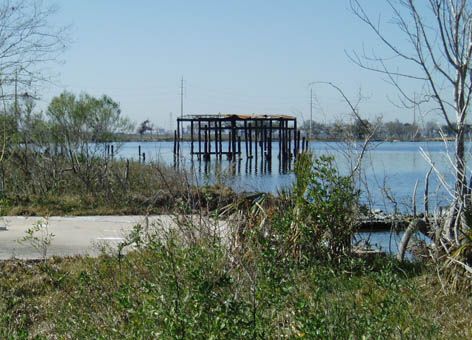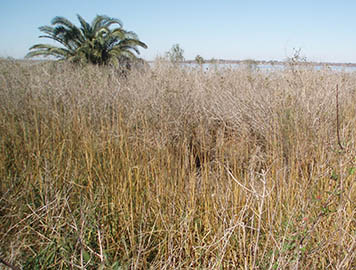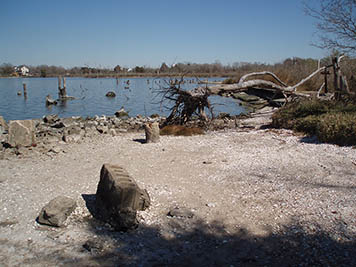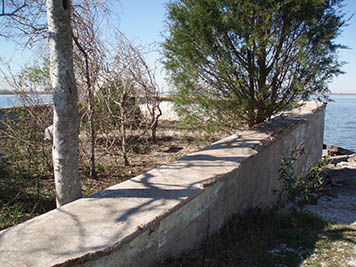Texas Restoration Projects to Transform Concrete to Marsh, Undoing Bayou's Pesticide-laden History
APRIL 12, 2013 — If, like most Americans, you live in a city, then you're probably familiar with their crowds, busy streets, and steel-and-glass skyscrapers. Wouldn't it be nice if you could occasionally break away from the city to watch wood storks fly by, or take a leisurely stroll on a trail surrounded by live oaks and tall grasses? For the lucky residents of Houston, Texas, they can make this happen in as little as 45 minutes at the Baytown Nature Center and Spring Creek Greenway. But these natural escapes hold a few surprising secrets. The waters and greenery of Baytown have their origins in an abandoned waterfront housing development, and their transformation from concrete to marsh, along with the preservation of Spring Creek's wetlands, actually owe some thanks to Greens Bayou, a previously pesticide-laden industrial site just down the interstate.

The Site
The Greens Bayou site, located in Houston, is 217 acres of chemical manufacturing facilities, a flood control ditch that leads into the bayou itself, and the undeveloped land that surrounds all of this. Greens Bayou is a tidally influenced area whose brackish waters run into those of the well-trafficked Houston Ship Channel. Historically, the area's chemical plants disposed of untreated liquid waste and wastewaters from manufacturing operations in unlined, earthen ditches, which then flowed into Greens Bayou. These ditches were the primary way pesticides were able to leach into the soil, sediment, surface water, and ground water in this environment. In particular, DDT and its by-products were found at high levels, signaling to us the potential for adverse effects for the bayou's bottom-dwelling invertebrates, fish, and aquatic-dependent wildlife.

The Investigation
Jessica White, a NOAA OR&R Regional Resource Coordinator, became involved with Greens Bayou in 2004. By this time, the Texas Commission on Environmental Quality (TCEQ) had commenced the remedial investigation under the Texas Risk Reduction Program. This investigation included a detailed assessment of risk to the environment, which involved sampling and chemical analysis of sediment, soil, water, and fish tissue from Greens Bayou. The assessment's results indicated that the natural resources found at this site were at risk of injury or loss.

This prompted the natural resources trustees—NOAA, U.S. Fish and Wildlife Service, TCEQ, and the Texas Parks and Wildlife Department—to initiate a Natural Resource Damage Assessment (NRDA) in 2005. This meant the trustees, including White, were performing their own assessment, which used information from the remedial investigation to quantify the harm done to the habitats, fish, birds, and wildlife there. As a result, their assessment continued on a parallel track to the remedial investigation. This collaboration helped them work more efficiently as they collected and analyzed data. At the conclusion of the damage assessment, the trustees determined that this chemical facility site required ecological restoration to offset the past injuries to the forested wetlands and submerged mud bottom habitats. The next step in the NRDA process was to identify suitable restoration projects which would benefit the natural resources that depended on the injured habitats. Restoration is defined as the rehabilitation, replacement, or acquisition of the equivalent natural resources that were lost or injured. In this case, the trustees selected both the route of restoration and acquisition to compensate the public for the loss of these natural resources. (The final damage assessment and restoration plan is available online. [PDF])

The Restoration
The restoration project they chose for the submerged mud bottom habitat was the creation of nearly 11 acres of estuarine marsh at the Baytown Nature Center located in Baytown, Texas. To accomplish this, the existing shoreline and adjacent area will be re-contoured to a lower elevation. Further lowering the elevation of the shoreline will allow more water to infiltrate the land and support the addition of marsh plants. However, this also involves breaking up the concrete sidewalks and foundations remaining from the area's past life as an upscale residential neighborhood known as Brownwood. In the 1940s and 50s, Brownwood became home to impressive two-story residences and their boathouses, framed by palm trees and the San Jacinto River. The death of this booming subdivision came slowly, delivered by local industry's massive extraction of water beneath Brownwood, which caused the land to subside significantly. More than two decades of hurricanes and storm surges began flooding residents out of their sinking homes, and after Hurricane Alicia devastated the area in 1983, the city of Baytown worked with the Federal Emergency Management Agency (FEMA) to buy out the last of Brownwood's homeowners.

Baytown then agreed to transform the abandoned neighborhood into a public park and nature center. One of the few surviving signs of Brownwood will be a swimming pool the trustees have decided to leave amid the re-created saltmarsh. Across town, on the north side of Houston, the trustees will replace Greens Bayou's lost forested wetland habitat with 100 acres of similar habitat, located in the Spring Creek Greenway. The acreage has already been acquired and placed under a conservation easement. This easement will protect the property, already surrounded by subdivisions, from development. It will also ensure the land is available for the public to enjoy through a number of activities such as nature hiking, biking, and bird-watching. Settlement of the Natural Resource Damage Assessment for the Greens Bayou case includes reimbursement for the trustee assessment and restoration oversight costs as well as the cost to implement the restoration projects (estimated at approximately $375,000 for the Baytown Nature Center project and $417,000 for the Spring Creek project). Both the Baytown Nature Center and Spring Creek Greenway are places where people can enjoy nature in the highly developed Houston area. By partnering with these existing initiatives, the trustees were able to ensure the restoration projects would build on the local momentum to protect and appreciate the natural environment while reversing the ecological damage done at Greens Bayou.
 An official website of the United States government.
An official website of the United States government. 